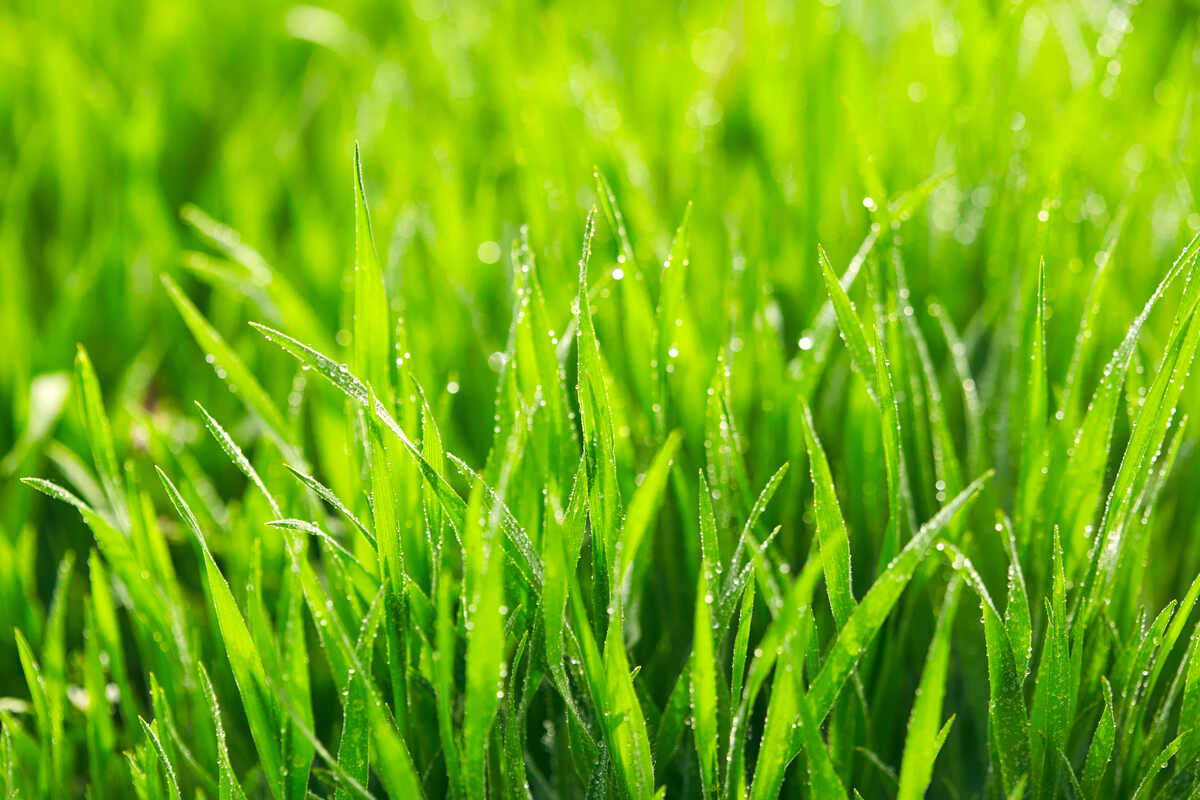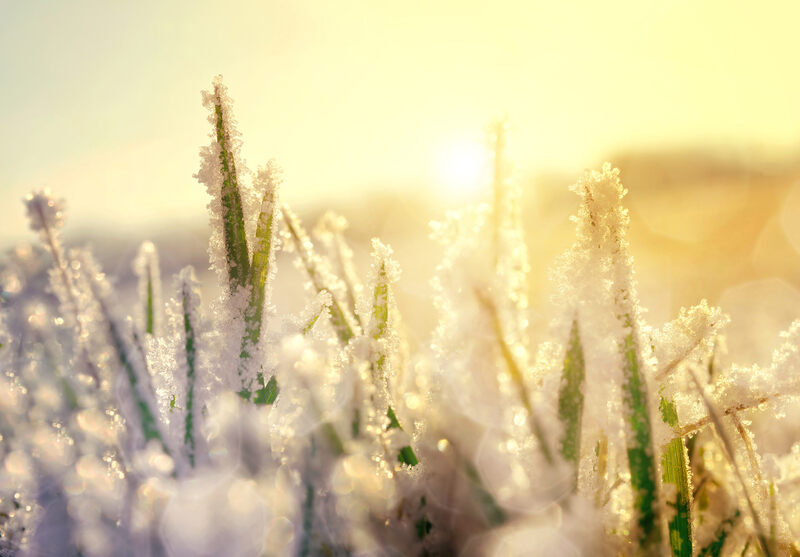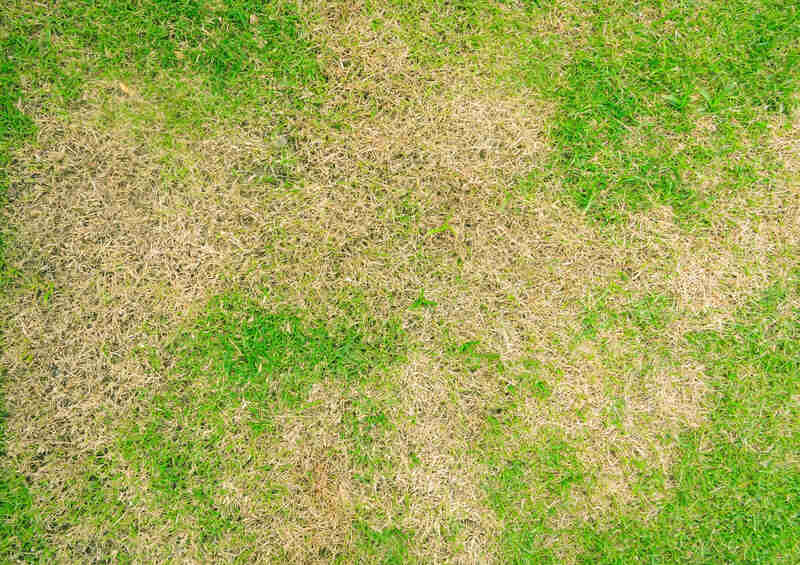
Crown hydration is excessive water uptake into the grass crown during warm winter days. When freezing temperatures return, overhydrated crowns form ice crystals and rupture.
It’s one of the reasons the lawn greens up with dead grass and bare spots in the spring. You can limit the injury if you know what you’re dealing with, how crown hydration works, and what factors make it worse.
What Causes Crown Hydration?

Crown hydration is caused by warm spells tricking the turfgrass into exiting winter dormancy too early.
When temperatures and sunlight decrease in late fall, turfgrass hardens for the winter. The adaptations are remarkable. Plants reduce their water intake and add more fatty acids to cell walls to increase flexibility. They also accumulate sugars, salts, and amino acids in their cells to lower the freezing point.
“In a very real sense, plants create their own “antifreeze,” says Sharon Walker, Master Gardener Volunteer at the University of New Hampshire Extension.
Warm spells trigger de-acclimation, reversing all these protective measures. Grass plants wake up from dormancy and start absorbing more water in preparation for spring greening. Much is stored in the crown, so grass plants end up with super-hydrated crowns when winter is far from over.
Why is crown hydration dangerous for turfgrass? If the warm spell is followed by a sudden freeze, water in the crown turns into ice crystals. When water freezes, it expands its volume, so ice crystals rupture cell walls and plant tissue, often destroying the crown.
The crown is the whitish, thick grass segment that connects the grassroots with the stems and grows close to the soil. It is also the plant’s growing point where all roots and stems develop. If the crown dies, the plant dies.
Perennial ryegrass (Lolium perene) and annual bluegrass (Poa annua) are the most susceptible to crown hydration. They are the first cool-season grasses to germinate and green up during a warm spell.
Factors that Increase Crown Hydration Damage
Excess water in the soil is the main factor that causes crown hydration and increases lawn thawing and freezing damage. High soil moisture is caused by:
- A wet winter with lots of snow and ice melting and waterlogging the soil during thaws.
- Depressions or low spots where water pools.
- Poor soil drainage, either due to high clay content or surface or subsurface compaction.
The second factor is incorrect turf preparation for winter, such as:
- Close mowing in late fall, especially in shaded areas. It limits the amount of carbohydrates grass can use to acclimate to winter conditions.
- Fall fertilization with high-nitrogen products. It delays the hardening process.
- Excessive thatch left on the lawn. It leads to elevated crowns that are more exposed to frost without a snow cover.
Sudden freezes, multiple thaw-and-freeze cycles, and extended freeze periods also increase the damage.
The High-Risk Period is from February to March
Crown hydration risk is highest from late winter to early spring, especially in February and March. It’s when repeated thaw and frost cycles with extreme temperature fluctuations occur.
Central and northern areas are the most affected across the United States. The cold, harsh winters increase the risk of turfgrass winterkill in these areas. Warm-season grasses in milder climates are also in danger during severe winters with below-freezing temperatures, with centipede grass being the most susceptible to crown hydration.
Signs of Crown Hydration Injury

Crown hydration often kills the plants, so the common signs of this type of winter turf injury include:
- Thinning turf
- Large patches of dead or dying turfgrass that look yellowish, brown, or straw-like
- Bare spots, often in low-lying areas
Crown hydration is only one cause of turf injury in winter. Low-temperature kill, winter desiccation, ice encasement, and snow mold damage also can cause thinning turf and bare patches in the spring.
Can You Repair Crown Hydration Damage?
Turfgrass damaged by crown hydration often dies, so to repair thinning grass and bare patches in your lawn, you need to replant: overseed or install sod and grass plugs.
Postpone lawn repairs until the grass is at least 3 inches tall, and you can proceed with the first mowing of the year. To prepare for overseeding, mow the grass a few times until you reach the lower end of the recommended mowing height for your grass type (don’t cut more than ⅓ of the grass blade in one mowing session). Remove the thatch if thicker than 0.5 inches, aerate, and plant the new grass.
How to Reduce Crown Hydration Damage
“Crown hydration damage continues to be one of the most destructive yet least preventable forms of winterkill,” says John Roberts from the University of New Hampshire.
Even so, there are ways to limit the damage to your turf, most of which have to do with how well you prepare the lawn for winter. Here are some cold-weather turf care tactics to follow:
- Improve drainage by aerating the soil, amending it with organic matter, leveling the lawn, or installing drainage systems along the yard if necessary.
- Dethatch the lawn before the grass enters dormancy.
- Avoid high-nitrogen fertilizers in late fall.
- Spread a potassium fertilizer before winter sets in. Studies show that a winter fertilizer with a 1:2 nitrogen-to-potassium ratio can reduce winter damage by 30%.
- Don’t build snow piles or snowmen on the lawn or nearby.
- Clean and repair the gutters to prevent melting snow and ice from leaking from the roof into the lawn.
Keep Your Lawn Safe From Winter Damage
Proper lawn maintenance can make your turfgrass more resilient to winter damage. Find an experienced lawn care professional with LawnStarter and ensure your lawn is always in the best shape possible.
Sources:
- DaCosta, M, Ebdon, J.S. (2023, May) Major Winter Injuries of Cool-Season Turfgrass in New England: Understanding, Prevention, and Recovery. UMass Extension Turf Program. https://ag.umass.edu/turf/fact-sheets/major-winter-injuries-of-cool-season-turfgrass-in-new-england-understanding-prevention-recovery
- Roberts, J. (1995, January). Winter Hydration Injury on Turf: Causes and Cures. Proceedings of the Michigan Turfgrass Conference. Volume 24, pg. 259-260. https://archive.lib.msu.edu/tic/mitgc/article/1995259.pdf
- Walker, S. (2018, December 4). Dormancy: A Key to Winter Survival. University of New Hampshire. https://extension.unh.edu/blog/2018/12/dormancy-key-winter-survival
- Landschoot, P. (2023, January 4) Winterkill of Turfgrasses. Pennsylvania State University Extension. https://extension.psu.edu/winterkill-of-turfgrasses
Main Photo Credit: Nik_Merkulov / Adobe Stock Free / License